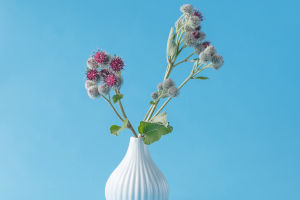Succulent plants have become increasingly popular due to their unique shapes and ease of care. With a wide variety of species, succulents are characterized by their ability to store water, allowing them to thrive in arid environments commonly found in deserts and semi-arid regions.
This article introduces five common succulent plants to help readers better understand these fascinating plants.
1. Echeveria
Echeveria, commonly known as the rose succulent, is a highly favored succulent plant recognized for its elegant rose-like shape. The leaves are typically thick and fleshy, displaying various colors from green to pink, purple, and even blue.
Echeverias thrive in bright sunlight, with their captivating colors best showcased in the morning and evening sun. They usually bloom in spring and summer, producing vibrant bell-shaped flowers that attract many bees and butterflies.
Care for Echeveria is relatively straightforward; maintaining dry soil with good drainage is key. Using specialized succulent soil or mixing regular soil with sand can enhance drainage. Applying diluted liquid fertilizer every two weeks can support healthy growth during the growing season.
2. Sansevieria
Sansevieria, or snake plant, is another common succulent. Its leaves are sword-shaped and typically deep green, adorned with prominent yellow or white stripes, making it visually appealing. Known for its high shade tolerance, Sansevieria is ideal for indoor growth and is a perfect home decoration choice.
This plant is easy to care for and is suitable for beginners. It requires minimal water, usually needing a drink only when the soil is completely dry. Sansevieria has a unique advantage: it can perform photosynthesis at night, releasing oxygen and purifying the air, making it an ideal plant for bedrooms.
3. Haworthia
Haworthia, known as the zebra plant, is a small succulent recognized for its distinctive translucent leaf tips and diverse shapes. The leaves typically exhibit dark green or gray-green colors, often featuring prominent white stripes. This slow-growing plant is perfect for small spaces like desktops or windowsills.
Haworthia prefers bright, indirect light, as direct sunlight can scorch its leaves. Watering should be done carefully, typically when the soil surface is dry while ensuring good drainage. Propagation is primarily achieved through offsets, making it a great option for gardening enthusiasts.
4. Sedum
Sedum, often called stonecrop, is a fast-growing succulent plant known for its strong adaptability. The leaves are fleshy and can vary greatly in shape, some resembling flowers, with a wide range of colors including green, red, and purple. Sedum can be used both as an indoor plant and for landscape design in gardens.
This drought-resistant plant has low soil requirements, thrives in sunny locations. The watering principle of "dry out before watering" should be followed to maintain soil drainage. Sedum can also be easily propagated through cuttings.
5. Crassula Ovata
Crassula ovata, commonly known as the jade plant, is recognized for its thick leaves and rounded form, symbolizing wealth and good fortune. The leaves are smooth and dark green, often edged in red, with a distinctive shape that is very popular. This succulent can grow relatively tall and thrive in bright sunlight.
Care for the jade plant is simple; it requires dry soil with good drainage. It has high light needs, particularly in winter, so providing ample sunlight is essential. Furthermore, during the active growth periods in spring and summer, fertilizing monthly can promote healthy growth.
With their unique beauty and ease of care, succulent plants are becoming a popular choice for many households. By understanding the five common succulent plants mentioned above, you can better select the plants that suit you and create a green living environment at home.


